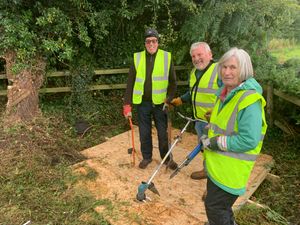MP pledges to help resolve saga of dead horse suck in river for more than a month
A Staffordshire MP has pledged to help resolve the ongoing saga of a dead horse which has not been removed from a beauty spot.

South Staffordshire MP Sir Gavin Williamson has called on the Environment Agency to take immediate action to remove the horse, which has been in the River Stour since March 11.
Despite the pleas of local residents and campaigners to remove the horse, no agency has yet taken responsibility for recovering the animal, with all claiming it is not down to them to remove it.
Sir Gavin said he understood how distressing it was for residents and visitors and said he would be taking steps to help get the horse moved, as well as saying the local authority should act on it.
He said: “It’s quote obvious that responsibility needs to be taken as it’s very distressing for residents and visitors alike. I am calling on the Environment Agency to take immediate action to remove this as it is quite clear that it is something they should be doing and I will getting immediately in contact with the chief executive asking for immediate action on this.
“You would hope that the owners of the horse would have taken responsibility for it because, as a right, you should, but as no-one is taking responsibility, it’s quite clear that the public authority should be the one responsible for this.”
While the waterfall has a Dudley postcode, DY8 5HS, the area falls under the jurisdiction of South Staffordshire District Council.
A spokesman for the council said that while it had tried to find a solution, it did not have the resources to handle the matter safely and said that as the carcass did not present a flooding or pollution risk, it was not prepared to take the risk to remove it.
The spokesman said: “South Staffordshire Council appreciates the sight of the carcass is unpleasant and despite the council not having a legal or statutory duty to remove the carcass from the watercourse, officers have been working hard to find a safe and cost-effective solution for its removal.
“This has, however, proved extremely challenging as we do not have the necessary resources or expertise to handle the matter safely ourselves.”
“We have approached a number of specialist contractors to undertake the removal, but due to a lack of vehicle entry points getting equipment on site is very difficult.
“This has been further complicated by the carcass being lodged in overhanging trees in very close proximity to a weir and fast flowing water, which presents significant risks.
“The council has been advised that the carcass does not present a flooding or pollution risk, therefore the cost to remove the carcass and the potential safety issues involved presents an unviable situation and a level of risk the council is not prepared to take, despite our best efforts of trying to find a solution to this matter.”
Julie Smith, who works in equine rescue, has been campaigning for the horse to be removed, and said she was getting frustrated at no-one taking responsibility for the horse. She said: “The horse needs to be moved but no-one is interested about it, saying they haven’t got the funds to do it. We can’t get the council out to work on it and they, the waterways, Environmental Health, Fire and Rescue, RSPCA and local councils just aren’t getting involved in this and I don’t know what else to do.”
“We just want to get someone to give it some respect and get it out of the water.”
She also said there were people living nearby who had offered to remove the horse themselves, but she had had to dissuade them from doing so.
She said: “I’ve got a lot of messages from people who are saying we should all get together, go down and get it out of the water, but I’ve had to explain that it’s not that easy.
“If the horse is de-composing, then if you try to pull at it, it might fall apart in front of them, which I wouldn’t want to see.
“If it can be removed, then we can scan for a microchip and trace it back to its owner and then get them to pay the costs for removing it.”





